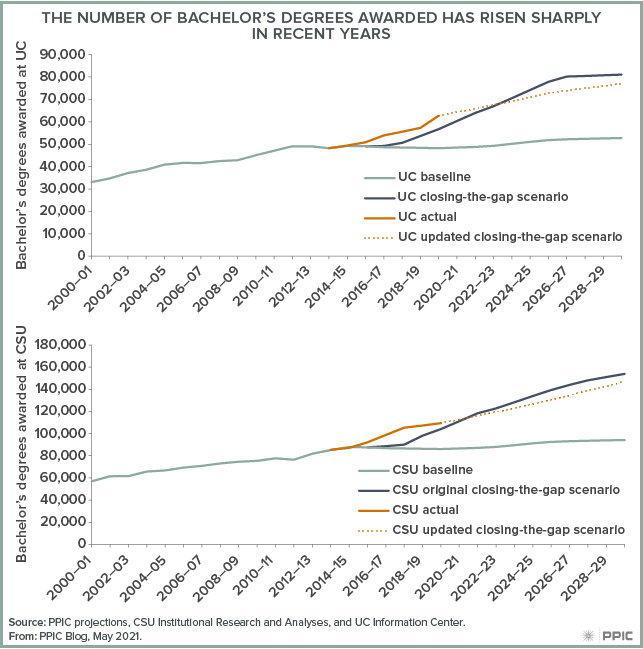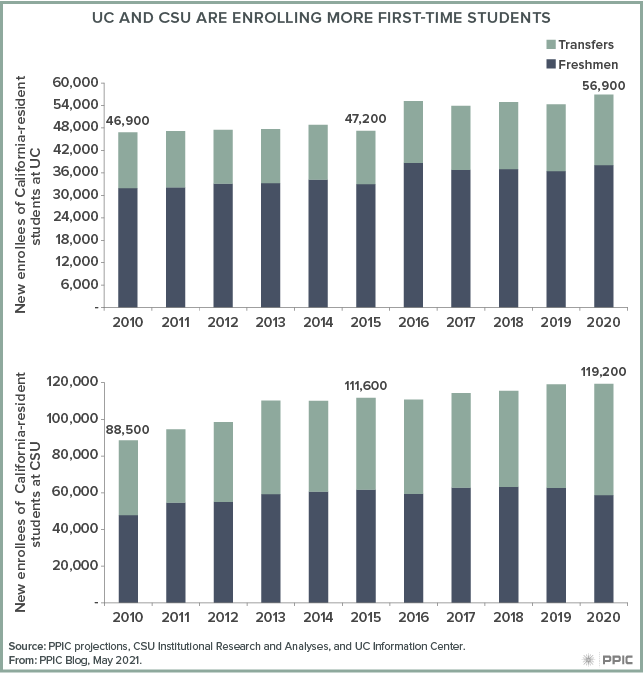Six years ago, PPIC projected a shortage of 1.1 million highly educated workers in California by 2030—a gap that could only be closed if the state and its colleges acted quickly and persistently. We identified ambitious targets that—if met—would close the degree gap, including large increases in access to the University of California (UC) and California State University (CSU) for both first-time freshmen and transfer students, as well as substantial improvements in graduation rates.
The state and its higher education systems largely accepted the challenge. Despite disruptions caused by the pandemic, California is currently on track to close the degree gap.
The concerted efforts of policymakers, higher education officials—including staff and faculty—and, of course, students have led to considerable gains. State General Fund allocations for each system have increased substantially since the Great Recession, allowing for higher enrollment and renewed efforts to improve student persistence and completion. Both UC and CSU exceeded PPIC’s original closing-the-gap targets, reducing the degree gap by almost 120,000.

Two primary actions have led to these gains.
First, increases in state funding have allowed UC and CSU to enroll substantially more first-time students from California—both freshmen and transfer students. At CSU, enrollment of new students increased 35% between fall 2010 and fall 2020. At UC, enrollment increased 21% over the same period. Notably, UC’s gains occurred primarily in one year, from 2015 to 2016, when the legislature and governor tied a $25 million allocation to increasing enrollment by 5,000 students. In that single year, total first-time enrollment of freshmen and transfer students went up 17%, with gains concentrated among African Americans and Latinos.
 Second, programs to improve student persistence and graduation rates have also paid off—and contributed to enrollment growth. These gains have been especially sharp at CSU, which has received substantial funding from the state to support its graduation initiative. At CSU, six-year graduation rates for entering freshmen increased from 57% in 2015 to 62% in 2020. At UC, four-year graduation rates for California-residency freshmen rose from 64% in 2015 to 71% in 2020. (Six-year graduation rates at UC remain very high, around 86%). Graduation rates for transfer students also increased at both systems.
Second, programs to improve student persistence and graduation rates have also paid off—and contributed to enrollment growth. These gains have been especially sharp at CSU, which has received substantial funding from the state to support its graduation initiative. At CSU, six-year graduation rates for entering freshmen increased from 57% in 2015 to 62% in 2020. At UC, four-year graduation rates for California-residency freshmen rose from 64% in 2015 to 71% in 2020. (Six-year graduation rates at UC remain very high, around 86%). Graduation rates for transfer students also increased at both systems.
These early successes are promising. Still, California needs to build on them if it is to close the degree gap fully. The pandemic has led to massive disruptions, with almost all instruction moved online. Yet the demand for college remains high. PPIC’s statewide survey shows that the vast majority of parents (78%) want their child to earn at least a bachelor’s degree. College readiness among high school graduates has increased, with the share of students completing the college preparatory requirements of UC and CSU now at an all-time high. And while community college enrollments have declined and applications to CSU have levelled off or even declined a bit recently, application levels at CSU are still near record highs and UC continues to set application records. All but one UC campus and many CSU campuses already do not have room to admit all eligible applicants.
Looking ahead, the governor’s office is working to establish a bachelor’s degree goal for the state that aligns with PPIC’s targets, and the May budget proposal provides substantial funding increases for the state’s colleges and universities. This should help the state meet continued strong demand for UC and CSU as college preparation improves and the transfer pathway becomes more efficient and effective. New initiatives, including reforms in remedial education at the community colleges and CSU, have the potential to substantially improve student success rates and boost transfer. New articulation agreements, such as the Associate Degree for Transfer, have streamlined the pathway from community colleges to four-year colleges, especially CSU. And an increased focus on improving student outcomes has led to multiple substantive reforms designed to increase persistence and completion at UC and CSU.
Finding ways to accommodate all eligible students and overcome the disruptions caused by the pandemic are pressing challenges. Through thoughtful planning and investment, closing the degree gap is possible. Improving access and completion is a necessary and critical component to ensuring that more low-income, first-generation, and underrepresented students enjoy the benefits of a college degree. The early progress highlighted here has led to greater access and success for underrepresented students, creating momentum to improve the well-being of all Californians.





